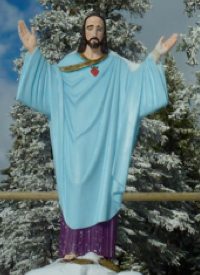
The Catholic-themed statue, which was erected in 1955 as a World War II memorial by a group of returning veterans, has been maintained over the years by a local Knights of Columbus post, and has been a popular stop-off for skiers visiting the Whitefish Mountain Resort. But in May 2011 the FFRF complained to the Forest Service, insisting that the monument violated the supposed constitutional separation of church and state.
In a letter to Forest Service officials, FFRF attorney Stephanie Schmitt warned: “It is a fundamental principle of Establishment Clause jurisprudence that the government cannot in any way promote, advance, or otherwise endorse religion…. The statue of Jesus Christ cannot legally remain in Flathead National Forest.”
To make clear the FFRF’s motivation, its president Annie Laurie Gaylor derided the statue and the efforts of local residents to maintain it. “The Knights of Columbus and its backers claim the Jesus statue memorializes World War II veterans — specifically Catholic members at Kalispell’s St. Matthew’s parish,” Gaylor wrote in a press release. “This is a sham designation that insults and excludes the many ‘atheists in foxholes’ and non-Christian veterans who defended our country.”
Gaylor insisted that the historic monument be moved immediately, observing that the “Knights of Columbus is a very wealthy organization with ample land where it may place Jesus statues privately, where they belong.”
Following an intense FFRF assault, the Forest Service initially caved in, announcing that it would not renew the special use permit that it had issued to the Knights of Columbus since the 1950s to maintain the monument in the national forest.
That decision prompted intervention from U.S. Representative Denny Rehberg (R-Mont.), as well as a campaign by the American Center for Law and Justice (ACLJ), a conservative legal advocacy group that has gotten the better of the FFRF in scores of First Amendment court cases. In a letter to Forest Service Chief Tom Tidwell, Rehberg went to bat for the veterans group that erected the monument, explaining: “Removal of this symbol of hope and faith is an insult to the sacrifices [veterans] so willingly gave our great country.”
Following a campaign led by the ACLJ, which prompted nearly 100,000 messages to the Forest Service in support of the statue, the federal forestry bureaucrats announced that they would reverse their decision and renew the permit allowing the statue to remain in place for another 10 years.
Chris Weber, supervisor for Flathead National Forest, explained that in making its decision, the Forest Service took into account the fact that the statue was eligible for placement on the National Register of Historic Places. “I understand the statue has been a long-standing object in the community since 1955,” Weber said, “and I recognize that the statue is important to the community for its historical heritage based on its association with the early development of the ski area on Big Mountain.”
Predictably, the FFRF announced that it would sue the Forest Service in an ongoing attempt to have the memorial removed. “A federal agency should not hold a vote on whether to obey the Constitution,” said Gaylor. “The U.S. Forest Service has unlawfully misused federal land owned by all of us to further Christianity in general, and Roman Catholicism in particular. This diminishes the civil and political standing of non-religious and non-Christian Americans, and shows flagrant governmental preference for religion and Christianity.”
By contrast, the ACLJ’s Jay Sekulow called the decision “a significant victory in defense of the history and heritage of the region.” He pointed out that “this statue of Jesus does not convey any government religious endorsement of religion. Instead, this historically important memorial is designed to commemorate the sacrifice made by those killed in World War II.”
Jeff Mateer of the Liberty Institute, another conservative group that helped to defend the monument, said that the statue “honors the ultimate sacrifice of the Tenth Mountain Division for whom it was erected following their service during World War II.” He said that the Forest Service’s decision to allow it to remain undisturbed “is a clear victory for the First Amendment, which prohibits government discrimination against this historic veterans memorial simply because of its religious viewpoint.”

